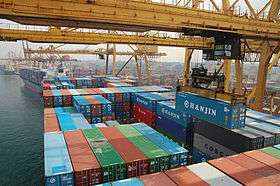Magampura Mahinda Rajapaksa Port
| Port of Hambantota | |
|---|---|
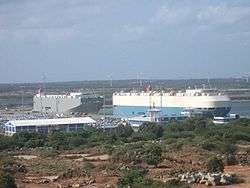 | |
| Location | |
| Country | Sri Lanka |
| Location | Hambantota |
| Coordinates | 06°07′10″N 81°06′29″E / 6.11944°N 81.10806°ECoordinates: 06°07′10″N 81°06′29″E / 6.11944°N 81.10806°E |
| Details | |
| Opened | 18 November 2010 |
| Available berths | 3 |
| IATA | HBT |
|
Website www | |
The Hambantota Port[1] (also known as the Magampura Mahinda Rajapaksa Port) is a maritime port in Hambantota, Sri Lanka. The first phase of the port was opened on 18 November 2010, with the first ceremonial berthing of the naval ship "Jetliner" to use the port facilities. It is named after former President Mahinda Rajapaksa.[2][3] Hambantota Port is built inland and operated by the Sri Lanka Ports Authority.[4] Total estimated construction cost of the Phase 1 of the project is US $361 million and out of which, 85% has been funded by the EXIM Bank of the People's Republic of China.[5]
Construction of the port commenced in January 2008. It will be Sri Lanka’s largest port, after the Port of Colombo. The Port of Hambantota will serve ships travelling along the east-west shipping route which passes six to ten nautical miles (19 km) south of Hambantota. The first phase of the port project will provide bunkering, ship repair, ship building, and crew change facilities.[6] Later phases will raise capacity of the port up to 20 million TEUs per year. When completed, it is claimed it will be the biggest port constructed on land to date in the 21st century.[7]
However, the Hambantota Port in 2016 made a revenue of US$11.81 million and incurred expenses of US$10 million as direct and administrative costs to report an operating profit of just US$1.81 million.[8]
As the port incurred heavy losses, making debt repayment difficult, in 2016 it was proposed to lease 80% of the port in a debt-for-equity swap[9] to the China Merchants Ports holding company (CMPort), who will invest 1.12 billion USD to revive the port under a public–private partnership.[10][11][12] Later, it was decided that under the agreement, CMPorts will divest 20% of its shares to a Sri Lankan company within ten years. CMPort will have to spend at least US$ 700-800 million or more to bring the port to operational level.[13] In July of 2017, the agreement was signed, but leasing only 70% of the Port to CMPort instead of the initially proposed 80%.[14]
In July 2018, it was announced that Sri Lanka would relocate its naval base at Galle to Hambantota.[15]
History
Background
The inland harbour on the Walawe river and the sea harbour on the bay of Godavaya in Ambalantota Trade were an important component in the economy of ancient Sri Lanka, and Godavaya was an important maritime settlement, serving Tissamaharama and Ridiyagama in the kingdom of Ruhuna. This port was first known to be operational in the general area of Hambantota around 250 BCE, when Chinese and Arabian merchants used it as part of the maritime silk route.[7] Around the 1st century CE, a furnace powered by monsoon winds was built near Embilipitiya, which used wind-based air supply to produce high carbon steel. This steel was exported to Rome and other European areas for the manufacture of armor and swords, with ships sailing to a port in Hambantota to obtain steel.[7]
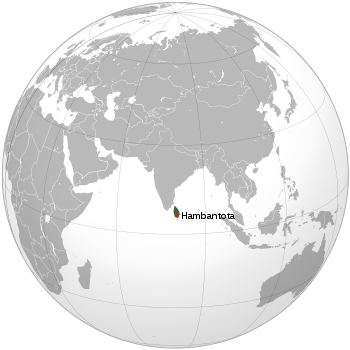
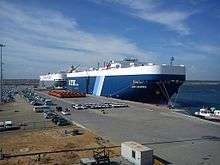
In 2002 Sri Lankan Prime Minister Ranil Wickremesinghe unveiled the "Regaining Sri Lanka" programme, which identified the Hambantota Seaport for development. The proposals for the port area include a refinery, petrochemical related industries, a coal powered thermal power station and a desalination plant.[16][17][18][19] The project did not proceed due to feasibility studies which showed the port as unfeasible.[20]
Construction and opening
Construction started on 15 January 2008, the Hambantota Port and was constructed by the Chinese companies China Harbour Engineering Company and Sinohydro Corporation.[7] The total cost of the first phase of the project is estimated at $360 million, excluding $76.5 million for the bunker terminal.[21] 85% of the funding was provided by the Chinese Government and the remaining 15% by the Sri Lanka Ports Authority.
Initially set to open in the first half of 2011, five months ahead of schedule,[22] the first phase of the project was completed by November 2010.
The harbor was formally declared open on 18 November 2010, by Sri Lanka's president Mahinda Rajapaksa with a ceremonial berthing of a vessel at the port. After sailing 90 nautical miles from the Naval Base in Galle, Sri Lanka Navy's ship "Jetliner" was the first vessel to drop anchor at the harbor.[23] Two vessels, Pradeepa 2 (a traditional sailing yacht) [24] and a commercial cargo ship followed the jetliner ceremonially sailing into the new harbour. Pradeepa 2 was chosen in recognition of Sri Lanka's age old role as a key stopping point on the ancient east-west silk trading route. Workers unloaded the first consignment of international cargo from Myanmar from the vessel "Seruwila" at the auspicious time of 06:21 GMT. A first day cover and a special commemorative stamp were issued by the Department of Post - Sri Lanka to mark the event.The launch of the second phase of the development of the port commenced at 06:27 GMT on the same day. There is also a move to create this port as a free port due to its commercial inactivity.[25]
However the Rajapaksa government turned down many proposals such as floating dock by China harbour Coroporation with a local investor, a proposal by a middle eastern firm to operate oil storage and bunkering was turned down due to influence from a young minister who wanted to make profit by keeping the activities under their control. Proposals for bottling factories, sugar bagging plants and grain processing plants were also refused.[26]
The port made losses of Rs.18.8 Billion resulting the debt payment burden falling on tax payers. After the fall of Rajapaksa government Prime Minister Ranil wickremesinghe visited China to solve the issue. As a result, Sri Lanka entered into a PPP agreement with China Merchants Port company to revitalize the Port alongside the creation of a large Special Economic Zone of 15,000 acres[9][10][11][27] However the plans including the Special Economic Zone received heavy opposition from Rajapaksa who threatened with social unrest.[28]
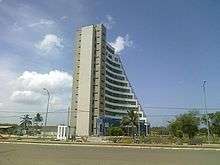
Location
Sri Lanka is situated along the key shipping route between the Malacca Straits and the Suez Canal, which links Asia and Europe. An estimated 36,000 ships, including 4,500 oil tankers, use the route annually.[7][29] However the only major port in Sri Lanka, the Port of Colombo, is catered towards container handling and is unable to provide facilities for port related industries and services.[30] Therefore, a new port was proposed near the city of Hambantota, which has a natural harbor and is located on the southern tip of Sri Lanka close to international shipping routes.[21]
A new port will help relieve pressure on the Colombo port, and also provide services to ships that normally take three-and-a-half-day detours from their shipping lanes to receive these services, including refueling, maintenance, logistics and buying provisions and medical supplies.[7][31] Proposals to build a port in Hambantota date back over three decades, but plans never got out of conceptual stages.[7] The Port of Hambantota project was finally launched after Mahinda Rajapaksa, who is a native of Hambantota, was elected President of Sri Lanka in 2005.[7] A leading maritime expert, Nuwan Peiris,[32] commented that this port is a conflict between '...the intervention of two Asian superpowers in Sri Lanka, namely China and India, in a bid to gain supremacy in the case of the former, and a proxy-battle to maintain its natural defense-perimeter in the case of latter. Chinese involvement in a harbour project (Hambantota) in the down-south of the island has given this battle a renewed intensity.'.
Facilities

The first phase of the Port of Hambantota will consist of two 600m general purpose berths, a 310m bunkering berth and a 120m small craft berth.[4][33] It will also contain a bunkering facility and tank farm which will include 8 tanks for marine fuel, 3 tanks containing aviation fuel and 3 for Liquid Petroleum Gas (LPG). A 15 floor administrative complex will also be constructed as part of the project.[7]
The mouth of the natural harbor at Hambantota has a 22-metre depth. When completed, the port will have a 1.5 km long breakwater, with a minimum basin depth of 17 m. This is compared to the 15.5 m depth of the Port of Colombo. The turning circle will be 600 m.[7] A dam will also be built to prevent flooding in nearby areas, and a seawall made of interlocking concrete blocks will protect the port from high seas.[31]
A $550 million tax-free port zone was set up outside the port.[29] In 2016 a 15,000 acre SEZ project was announced with 5,000 acres from Hambantota and the rest from Monaragala, Ambilipitiya and Matara.[34]
The finished project is expected to provide indirect employment to over 50,000 people.[7]
Future expansion
The second phase of the Port of Hambantota project, which will include a container terminal, is expected to be completed by 2014. The second stage of the port is estimated to cost around US$750 million.[35] The third phase will include a dockyard.[29] Upon completion, the port will cover 4,000 acres (16 km2) of land and accommodate 33 vessels at any given time, making it the largest port in South Asia.[7]
Port operations
The SLPA had decided to divert all vehicle shipments to the Ruhunu Magampura Mahinda Rajapaksa International port from May 31, 2012 as a measure to relieve the congestion at Sri Lanka's main port Colombo Harbour. On June 6, 2012, Ruhunu Magampura Mahinda Rajapaksa International Port officially started transshipment operations with the N4K FRICIA ship from Japan containing 15 vehicles and the Ellison Sun with 1000 vehicles from Chennai Harbour, India.[36][37]
Japanese, South Korean and Indian car makers have begun transshipping increasing numbers of vehicles through the port. In the first nine months of 2014, the number of vehicles handled at Hambantota crossed the 100,000 mark, up more than 300% compared to the same period in 2013, with the number of ship calls more than doubling to 161. The biggest user of the port is the Hyundai plant near Chennai while Tata and Maruti vehicles also come from Mumbai. In future, all Hyundai vehicles made in South Korea, China and India will be transshipped through Hambantota 15,000 units a month once more yard space is available.[38]
In April 2017, making a historic landmark in Sri Lanka, the world's largest pure car and truck carrier (PCTC), the MV Hoegh Trigger, arrived on her maiden call at the Port of Hambantota.[39]
Incidents
In December 2016, a mob of workers who were believed to be backed by Rajapaksa loyalists vandalised the port and took several ships hostage.The 13-storey building which was taken over by the strikers was flooded, and CCTV systems and electricity shut down. However swift action by Navy rescued the ships and began repairing damaged infrastructure thus reducing the damage.The Rajapaksa involvement was further proven by Rajapaksa loyalists' support of the strikers and wearing of black bands in support; in addition many of the leaders of the strike well as a protest against the SEZ that happened in Hambantota alongside the strike was led by members of the Nil Balakaya, an organization created by Namal Rajapaksa.[40][41] As a result, a shipping line also sent a bill of $400000 as damages to the ports authority.[42] The said workers were politically appointed by Nil Balakaya during the Rajapaksa regime and lacks legal documents to validate their employment[43] However the government and Navy Commander Vice Admiral Ravindra Wijegunaratne has come under extreme criticism from Civil activists and media movements over an assault on a journalist during this protest in Hambantota port. [44][45]
Lease to China
On July 28, 2017, Prime Minister Ranil Wickramasinghe announced that lease would be signed the next day[46] and on July 29, 2017, Sri Lanka Ports Authority (SLPA) and China Merchant Port Holdings signed an agreement on the Hambantota Port to lease the port to China Merchant Port Holdings for 99 years. The government of Sri Lanka kept the ownership of the port and lease it for 99 years. The deal gave the Sri Lankan government $1.4 billion, that they will be using to pay off the debt to China. This will stop the Sri Lanka Ports Authority paying off debt of Magampura Port from the profit of the Colombo port.[47] The deal had been delayed by several months over concerns that the port could be used for military purposes and also government had to face huge opposition to this deal from trade unions and opposition political parties who called it a sellout of the country's national assets to China.[48][49] The large Chinese loans, inability of the Sri Lankan government to service the loans, and subsequent 99-year Chinese lease on the port have lead to accusations that China was practicing Debt trap diplomacy.[50][51]
See also
References
- ↑ ‘Mahinda Rajapaksa Port’ in Hambantota Archived 2013-03-03 at the Wayback Machine.
- ↑ "Hambantota Port to be opened on President's birthday: Chamal". Daily Mirror. 2010-02-17. Retrieved 10 March 2010.
- ↑ B. Muralidhar Reddy (2010-11-18). "Hambantota port opened". The Hindu. Retrieved 2010-11-20.
- 1 2 "Development of Port in Hambantota". Sri Lanka Port Authority. Archived from the original on 6 March 2010. Retrieved 10 March 2010.
- ↑ "Archived copy". Archived from the original on 2010-03-06. Retrieved 2010-03-10.
- ↑ "Hambantota to ease Colombo Port congestion". Daily News. 2010-02-22. Retrieved 10 March 2010.
- 1 2 3 4 5 6 7 8 9 10 11 12 Sirimane, Shirajiv (2010-02-21). "Hambantota port, gateway to world". The Sunday Observer. Archived from the original on 24 February 2010. Retrieved 10 March 2010.
- ↑ http://www.dailymirror.lk/article/Hambantota-Port-sale-in-perspective-122278.html
- 1 2 "Sri Lanka's Hambantota port loses Rs18.8bn a year". www.economynext.com. 2016-11-11. Retrieved 2016-12-09.
- 1 2 "Framework agreement signed with Chinese company to develop Hambantota port". Hiru News. Retrieved 2016-12-09.
- 1 2 "Agreement signed with Chinese Merchants to develop H'tota Port on PPP Model". Retrieved 2016-12-09.
- ↑ Michael Marray (2016-12-14). "Sri Lanka plans to lease Hambantota Port to China". TheAsset.com.
- ↑ Namini Wijedasa (19 March 2017). "Hambantota port deal: Two major clauses to appease critics". Sunday Times. Retrieved 19 March 2017.
- ↑ "Sri Lanka signs deal on Hambantota port with China". bbc.com/news. 2017-07-29. Retrieved 29 July 2017.
- ↑ Reuters (July 2, 2018). "Sri Lanka to Shift Naval Base to China-Controlled Port City". Voice of America.
- ↑ "Lanka, Japan agree on peace talks, donor confab".
- ↑ "REGAINING SRI LANKA -Part 2" (PDF).
- ↑ "Regaining Sri Lanka Physical infrastructure Development Plan".
- ↑ "Online edition of Daily News - Business". archives.dailynews.lk. Retrieved 2016-12-09.
- ↑ "Hambantota Harbour Dream come true". Retrieved 30 July 2017.
- 1 2 "Hambantota project 'five months ahead of schedule'". Portworld News. 2010-03-08. Retrieved 10 March 2010.
- ↑ Ramani Kangaraarachchi (2010-03-24). "Hambantota Port to be ready ahead of schedule". Daily News. Retrieved 2010-11-20.
- ↑ "First ship enters the Magampura Port today". The official Government News Portal of Sri Lanka. 18 November 2010. Retrieved 21 November 2010.
- ↑ Government of Sri Lanka. "New Port Opening Promises Economic Boost for Sri Lanka". PR Newswire. Retrieved 20 November 2010.
- ↑ http://www.sundaytimes.lk/index.php?option=com_content&view=article&id=18252:free-port-what-does-it-mean-to-us&catid=79:analysis&Itemid=565
- ↑ "ePaper: | Online edition of Daily News - Sri Lanka". epaper.dailynews.lk. Retrieved 2016-12-17.
- ↑ "Sri Lanka To Sell 80 Percent Of Hambantota Port To China". Retrieved 2016-12-09.
- ↑ Shepard, Wade. "Former Sri Lankan President Warns Of Social Unrest If China Carries Out Its Plan In Hambantota". Forbes. Retrieved 2016-12-09.
- 1 2 3 Ondaatjie, Anusha (2010-03-08). "Sri Lanka to Seek Tenants for $550 Million Tax-Free Port Zone". Businessweek. Retrieved 10 March 2010.
- ↑ "Hambantota will 'ease' Colombo congestion". Portworld News. 2010-02-22. Retrieved 10 March 2010.
- 1 2 "Hambantota project 'can spearhead' developments". Portworld News. 2009-09-22. Retrieved 10 March 2010.
- ↑ "Hambantota Harbour and an Exile's Return – Geo-Political Dimensions of an Invasive Species". Intellibriefs.Blogspot.de. Retrieved 23 September 2017.
- ↑ Sirimane, Shirajiv (2010-03-07). "H'tota port project ahead of schedule". The Sunday Observer. Retrieved 10 March 2010.
- ↑ "Special Economic Zone at Hambantota port :State will keep ownership of land: Malik".
- ↑ "More ships to call at H'tota port". Sunday Observer. 2010-11-21. Retrieved 2010-11-21.
- ↑ "Sri Lanka's southern Hambantota Port begins commercial operations". www.ColomboPage.com. 6 June 2012. Retrieved 23 September 2017.
- ↑ "Operations commence at Hambantota Port". Port Technology. 6 June 2012.
- ↑ Gunasekera, Rohan (17 December 2014). "Shipping focus: The unexpected rise of Hambantota port". Automotive Logistics.
- ↑ "World's largest car carrier called at Hambantota port". www.HellenicShippingNews.com. 3 April 2017. Retrieved 23 September 2017.
- ↑ "Swift involvement reduced potential losses to port: Navy".
- ↑ "Hambantota moves in step with the Nation".
- ↑ "'K' LINE RETURNS TO HAMBANTOTA".
- ↑ "H'tota Port employees have no legal docs to validate employment: Minister".
- ↑ "Navy Commander Attacked Journalist On Human Rights Day".
- ↑ "FMM demands probe against Navy Commander over H'tota attack".
- ↑ "Hambantota Port agreement to be signed tomorrow - PM". www.Adaderana.lk. Retrieved 23 September 2017.
- ↑ "Hambantota port agreement signed". www.Adaderana.lk. Retrieved 23 September 2017.
- ↑ "Sri Lanka, China seal controversial $1bn port deal - Kuwait Times". KuwaitTimes.net. 29 July 2017. Retrieved 23 September 2017.
- ↑ Mitra, Devirupa. "Despite Security Assurances, Chinese Consolidation of Sri Lankan Ports Remains a Worry for India". TheWire.in. Retrieved 23 September 2017.
- ↑ Marlow, Iain (17 April 2018). "China's $1 Billion White Elephant". bloomberg.com. Retrieved 2018-09-15.
- ↑ Chellaney, Brahma (2017-01-23). "China's Debt-Trap Diplomacy". Project Syndicate. Retrieved 2018-09-15.
External links
| Wikimedia Commons has media related to Magampura Mahinda Rajapaksa Port. |
